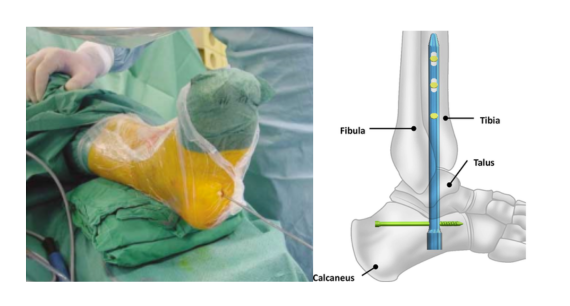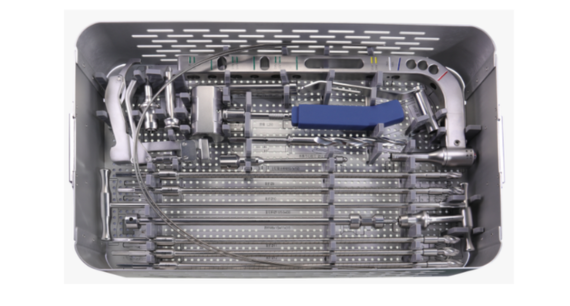1. Tibiotalocalcaneal Intramedullary Nail
The Tibiotalocalcaneal (TTC) Intramedullêre spyker is 'n spesiaal ontwerpte fiksasie toestel wat bedoel is vir gebruik in komplekse agter-voet fusie prosedures wat die enkel betrek (tibiotas) en subtalêre gewrigte. Hierdie retrograde spyker word deur die calcaneus geplaas (hakskeenbeen), reis deur die talus, en strek tot in die tibia. It incorporates locking screw options both distally (in calcaneus and talus) and proximally (in tibial diaphysis) and is designed to share load across the fusion construct, minimize soft-tissue disruption, and maintain hind-foot alignment while promoting osseous union.

2. What Is Tibiotalocalcaneal Arthrodesis?
Tibiotalocalcaneal arthrodesis (TTCA) is a fusion procedure involving the tibia, talus, and calcaneus — effectively eliminating motion at the ankle and subtalar joints.
It is indicated in end-stage arthritis, deformity, or collapse of the hind-foot where pain and instability prevent normal gait.
Common underlying causes include:
Post-traumatic arthritis after severe ankle injury
Failed ankle fusion or failed total ankle arthroplasty
Talar avascular necrosis
Charcot neuroarthropathy or diabetic deformity
Severe congenital or acquired deformities requiring correction
The objective is to achieve a stable, plantigrade, pain-free foot that allows ambulation and limb preservation.
3. Clinical Experience and Outcomes
In one of the early series of ten patients undergoing TTC fusion with a retrograde IM nail, the average pre-operative AOFAS (American Orthopaedic Foot & Ankle Society) score improved from 39 points to 69 points post-operatively; VAS pain decreased from 8.3 aan 2.0. Ankle and subtalar fusion was achieved in 18 van 20 joints.
In a larger study of 117 patients (61 diabetic, 56 non-diabetic) treated with retrograde IM nailing, overall complication incidence was 45.2%; limb salvage was achieved in 96.8% of diabetic patients and 94.7% of non-diabetics.
More recently, a study of 26 patients using retrograde IM nailing with partial fibulectomy and onlay bone grafting found complete ankle fusion in 80.8% at 6 maande, rising to 100% by 12 maande; subtalar fusion reached 80.8% at final follow-up, and significant functional improvements were reported.
Learning points from cases:
Fixation stability and alignment matter: longer nails reaching tibial diaphysis help reduce stress fractures near nail tip.
Bone loss or voids (Bv., talar necrosis) often require bone graft or allograft use, which may raise risk of complications.
Comorbidities (rook, diabetes, vascular disease, infection history) increase risk of non-union or delayed wound healing.
4. Surgical Instrument Tool
This instrument tool allows surgeons to perform stable, minimally invasive hind-foot fusion with reproducible outcomes.


5. Konklusie
The Tibiotalocalcaneal Intramedullary Nail has become an essential implant in modern orthopaedic foot and ankle reconstruction.
It offers a powerful limb-salvage option for patients suffering from advanced hind-foot pathology,especially when other reconstructive procedures have failed.
By combining mechanical stability, load sharing, and biologic support (through bone grafting), TTC nailing achieves fusion rates above 85%, even in medically complex cases.
Ongoing innovations in implant geometry and minimally invasive approaches continue to expand its clinical success and patient outcomes.
Noot:Die kopiereg behoort aan die oorspronklike skrywer en die tydskrif,Plasings is slegs vir leer en kommunikasie.